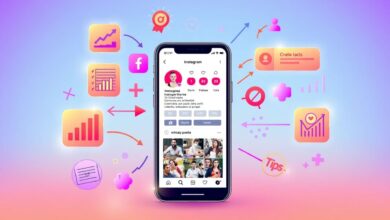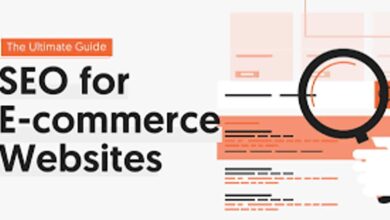SEO, Web Design & CRO: A Strong Digital Foundation
Building a High-Performance Website: Integrating SEO, Web Design, and CRO
In today’s digital world, getting your SEO, web design, and CRO right from the start is crucial. Think of it as building a house. You need a strong foundation, or the house might fall. This is why a solid digital foundation is so important.
SEO, web design, and CRO are like the bricks, windows, and doors of your digital house. SEO, which stands for Search Engine Optimization, helps people find your website on Google. Web design makes your site look nice and easy to use. CRO, or Conversion Rate Optimization, helps turn visitors into customers.
When a search marketing specialist company works on these three things together, your website can shine. SEO makes sure your site shows up when people search for things you offer. Good web design keeps people on your site because it looks good and is easy to navigate. CRO helps visitors do what they want, like buying a product or signing up for a newsletter.
These elements work like a team. SEO brings people in, web design keeps them interested, and CRO helps them take action. When all three work together, your online success can grow fast. A well-built site can rank higher on search engines, attract more visitors, and turn them into loyal customers.
By focusing on SEO, web design, and CRO from the start, you build a strong online presence. This way, you set your business up for long-term success. Don’t wait to get these rights. Start now and watch your business thrive.
Read Also: 7 Essential Tips for Google Ads Optimization
SEO: Laying the Groundwork for Visibility
Getting your website noticed by lots of people is like putting up a big sign that says, “Come and see!” This is where SEO comes in. SEO, which stands for Search Engine Optimization, is like laying the groundwork for your website to be seen by as many people as possible.
It’s like planting seeds in the ground so they can grow into big, beautiful flowers. SEO helps your website show up when people search for things online. So, if you want your website to be visible to lots of people, SEO is the way to go.
Understanding the Basics of SEO
SEO stands for Search Engine Optimization. It helps people find your website on search engines like Google. When someone searches for something, SEO makes sure your site shows up. This is very important because it brings visitors to your website.
Keyword Research: The Cornerstone of Effective SEO
Keyword research is super important for SEO. It’s like finding the right puzzle pieces to fit into your website. Keywords are the words people type into search engines when they look for something. When you know the right keywords, you can use them in your content. This helps people find your site.
Why is keyword research important?
It helps you understand what people are searching for. If you know what words they use, you can make your website match those searches. This makes your site show up higher in search results. More people will visit your site, and you can get more customers.
How do you find the right keywords? There are tools and techniques to help.
- Google Keyword Planner: This tool shows you popular keywords. You can see how often people search for them and find new keyword ideas.
- Ubersuggest: This tool helps you find keywords and gives you ideas for new ones. It also shows how hard it is to rank for a keyword.
- Answer the Public: This tool shows questions people ask online. You can use these questions as keywords in your content.
- Competitor Analysis: Look at websites similar to yours. See what keywords they use. This gives you ideas for your site.
- Brainstorming: Consider what words you would use to find your site. Ask friends and family for ideas too.
Once you find good keywords, use them in your website content. Please put them in titles, headings, and throughout the text. But don’t use them too much. The content should still make sense and be easy to read.
By doing keyword research, you make your site better for search engines and visitors. This helps your website get more traffic and grow your business.
See Also: How a Keyword Density Checker Can Optimize Your Content for Search Engines
On-Page SEO Best Practices
On-page SEO is about making your website content great for search engines and visitors. It helps people find your site and keeps them interested when they visit.
Here are some best practices for on-page SEO.
- Optimizing content for search engines means using the right words and making your content easy to read. Start by using your keywords naturally in your text. Put them in the title, in the first paragraph, and a few times throughout the content. But don’t overdo it. Your writing should still sound natural and make sense.
- Meta tags are small bits of text that tell search engines about your page. The most important ones are the title tag and the Meta description. The title tag is the title of your page. It should include your main keyword and be interesting to read. The Meta description is a summary of your page. It should also have your keyword and make people want to click on your link.
- Headers are like the titles and subtitles in your content. They help break up the text and make it easier to read. Use your keywords in some of your headers. This helps search engines understand what your page is about. It also helps visitors find the information they need quickly.
- Internal linking is when you link to other pages on your website. This helps visitors find more of your content and stay on your site longer. It also helps search engines find and index your pages. Use descriptive words for your links, so people know what to expect when they click.
By following these on-page SEO best practices, you make your content better for search engines and more useful for visitors. This helps your site rank higher in search results and keeps people coming back.
See Also: 9 Intelligent Tips to Building a Winning SEO Strategy
Technical SEO: Ensuring a Strong Backend
Technical SEO makes sure your website works well behind the scenes. It’s like making sure the engine of a car runs smoothly. This helps search engines find and understand your site.
Here are some important parts of technical SEO.
- Site speed is how fast your website loads. If your site is slow, people might leave before it finishes loading. To make your site faster, you can use smaller images, reduce the number of plugins, and use a good hosting service. Faster sites make visitors happy and help your site rank higher in search results.
- Mobile-friendliness means your site looks good and works well on phones and tablets. Many people use their phones to browse the internet. If your site doesn’t work well on mobile devices, you might lose visitors. To fix this, use a responsive design that adjusts your site for different screen sizes. Test your site on different devices to make sure it looks good everywhere.
- Indexing is how search engines find and list your website. If search engines can’t index your site, people won’t find it in search results. To help search engines index your site, create a sitemap. A sitemap is a list of all the pages on your website. Submit your sitemap to search engines like Google. This helps them understand your site better.
- Common technical issues can hurt your SEO. One issue is broken links. These are links that don’t work anymore. Fix broken links by updating or removing them. Another issue is duplicate content, which is when the same content appears on multiple pages. Search engines don’t like this. Fix it by combining similar pages or using redirects.
Sometimes, your site might have errors that prevent search engines from indexing it. Use tools like Google Search Console to find and fix these errors. This helps keep your site in good shape.
See Also: The 18 best SEO plugins for WordPress in 2024
Web Design: Creating an Engaging User Experience
Making your website fun and easy to use is like setting up a playground where everyone wants to play. That’s what web design is all about. It’s like creating a special place online where people can have a great time.
Web design helps make your website look nice and work well so that visitors enjoy their time there. Just like a good book with colorful pictures, web design makes your website engaging and exciting for everyone to explore.
Read Also: How to Hire the Best Web Designer for Your Business
The Role of Web Design in User Engagement
Web design plays a big role in how people feel about your website. When someone visits your site, their first impression is very important. If they like what they see, they will stay longer. If not, they might leave right away. This is why good design matters so much.
First impressions matter because they set the tone for the rest of the visit. Imagine walking into a messy room. You wouldn’t want to stay there, right? The same goes for websites. If a site looks nice and is easy to use, people will feel comfortable and want to explore more. Website designers know how to make a site look inviting and professional. This helps keep visitors on your site longer.
The impact of design on user perception is huge. When a site looks good, people trust it more. They think the business is reliable and worth their time. Good design makes people feel welcome and valued. It also helps them find what they need quickly. If a site is confusing or ugly, visitors might leave and never come back.
The principles of effective web design are like the rules that website designers follow to make a site great.
Here are some important ones:
- Simplicity: Keep your design clean and simple. Too many things on a page can be overwhelming. Simple designs help visitors focus on what’s important.
- Navigation: Make it easy for visitors to find their way around. Use clear menus and buttons. People should find what they need without getting lost.
- Consistency: Use the same colors, fonts, and styles throughout your site. This makes it look professional and put together.
- Mobile-friendliness: Make sure your site works well on phones and tablets. Many people use these devices to browse the web. A mobile-friendly site keeps them happy.
- Fast loading times: Make sure your site loads quickly. People don’t like to wait. Fast sites keep visitors from getting frustrated.
Good web design is like a friendly welcome mat for your site. It invites people in and makes them want to stay. By following these principles, website designers create sites that are engaging and enjoyable to use. This helps keep visitors happy and makes your site successful.
See Also: Web Design SEO Tips To Improve Conversions
Responsive Design: Catering to All Devices
Responsive design makes sure your website looks good on all devices. This means it works well on computers, tablets, and phones. It’s very important because many people use their phones to browse the internet. If your site isn’t mobile-friendly, you might lose visitors.
The importance of mobile-friendly design is huge. Imagine trying to use a website on your phone, but everything is too big or too small. You would get frustrated and leave. A mobile-friendly site makes sure this doesn’t happen. It adjusts to fit the screen size, so everything looks just right. This keeps visitors happy and makes them want to stay on your site longer.
Techniques for creating responsive websites help web designers make sure your site works on any device.
Here are some important ones:
- Flexible layouts: Use flexible grids and layouts that change size depending on the screen. This way, your site looks good whether it’s on a big computer screen or a small phone.
- Responsive images: Make images flexible too. They should resize to fit the screen. This helps the site load faster and looks better on any device.
- Media queries: Use media queries in your CSS (the code that styles your website). Media queries let your site check the device’s size and change the layout accordingly. This helps create a tailored experience for each user.
- Mobile-first design: Start designing your site for mobile devices first, and then make it bigger for tablets and computers. This way, the most important parts of your site work well on small screens.
- Touch-friendly elements: Make sure buttons and links are easy to tap on a touch screen. If things are too small, people might have a hard time using them. Big, easy-to-tap elements help make your site user-friendly.
By using these techniques, web designers create responsive websites that work well on any device. This helps you reach more people and keeps them happy when they visit your site. Responsive design makes sure everyone has a good experience, no matter how they access your site.
User-Centered Design: Putting Your Audience First
User-centered design means making your website with the people who use it in mind. This helps create a site that is easy and fun to use. When you put your audience first, they will enjoy their time on your site and want to come back.
Understanding user behavior and preferences is the first step. This means learning what your visitors like and how they use your site. Watch how they move around your site and see what they click on the most. You can use tools like Google Analytics to see which pages they visit and how long they stay. This helps you know what they find interesting.
Ask questions like:
- What do they look for when they visit your site?
- Do they prefer lots of pictures or more text?
- Are they looking for information or trying to buy something?
By knowing these things, you can make your site fit their needs.
Incorporating user feedback into the design is also important. This means listening to what your visitors say about your site. You can ask them directly with surveys or feedback forms. Find out what they like and don’t like. If many people say the same thing, it’s a good idea to make changes.
For example, if users say your site is hard to navigate, make the menu simpler. If they want more pictures, add some. Small changes based on user feedback can make a big difference.
Also, test your changes to see if they work. Show the new design to a few users and see what they think. This is called user testing. If they like it, you can make the change permanent. If not, you can try something else.
By focusing on user behavior and preferences and using their feedback, you make your site better for everyone. This keeps your audience happy and helps your site succeed. User-centered design means always thinking about what your visitors want and need.
Design Elements that Enhance SEO
Designing your website with SEO in mind can help it rank higher in search engine results. Here’s how design choices can impact SEO and some best practices for SEO-friendly design.
How design choices can impact SEO:
- Page Speed: When your website loads quickly, people are happier and stay longer. Search engines like Google also prefer fast-loading sites.
- Mobile-Friendliness: If your site works well on phones and tablets, search engines will like it more. Many people search on mobile devices, so it’s important to have a mobile-friendly site.
- Structured Data: Adding structured data to your site helps search engines understand what your content is about. This can improve your chances of showing up in special search result features like rich snippets.
- Optimized Images: Using optimized images with descriptive filenames and alt text can help search engines understand your content better.
- Internal Linking: Linking to other pages on your website helps search engines discover and index more of your content.
See Also: What Is the Significance of Web Design for Your Key Audience
Best practices for SEO-friendly design:
- Simple and Clean Layout: Make sure your website design is clean and easy to navigate. This helps visitors find what they’re looking for quickly.
- Clear Navigation: Use clear menus and navigation bars to help visitors move around your site easily.
- Keyword Placement: Include your target keywords in your page titles, headings, and throughout your content, but make sure it sounds natural.
- Responsive Design: Ensure your website design is responsive, meaning it adapts to different screen sizes and devices.
- Optimized URLs: Use descriptive URLs that include keywords related to your content.
- Avoid Flash: Flash content can be difficult for search engines to crawl, so it’s best to avoid it.
By incorporating these design elements and best practices into your website, you can enhance its SEO performance and improve its chances of ranking higher in search engine results. Remember, the goal is to create a user-friendly and accessible website that both visitors and search engines will love.
See Also: 12 Principles of a Great Web Design
CRO: Turning Visitors into Customers
Turning visitors into customers is like turning magic beans into a beanstalk that reaches the sky. This is what CRO, or Conversion Rate Optimization, is all about. CRO helps make sure that when people visit your website, they don’t just look around and leave.
Instead, it helps them do what you want them to do, like buying something or signing up for something fun. It’s like a special potion that turns visitors into happy customers who keep coming back for more adventures on your website.
What is CRO and Why It’s Essential
CRO, which stands for Conversion Rate Optimization, is super important for websites. It’s like making sure more people who visit your site do what you want them to do, like buying something or signing up for a newsletter.
Definition and importance of Conversion Rate Optimization: CRO is all about making your website work better for you. It helps turn more of your visitors into customers. Imagine having a lemonade stand. CRO is like making your lemonade taste so good that everyone who tries it wants to buy more. It’s about making your website super awesome so people want to do what you want them to do.
Key metrics to track for CRO success: There are some important things you can track to see if your CRO is working. One is your conversion rate. This is like a special number that tells you how many people are doing what you want them to do on your site. Another is the bounce rate. This tells you how many people leave your site right away without doing anything. You want this number to be low. There’s also an average session duration. This tells you how long people stay on your site. The longer they stay the better.
So, by using CRO, you can make your website even better and get more customers. It’s like using a conversion rate calculator to make sure you’re doing everything right. And when you do, you’ll see more people doing what you want them to do on your site, which is super cool!
Optimizing Landing Pages for Conversion
Making landing pages super awesome helps get more people to do what you want them to do, like buying something or signing up for something cool. Here’s how to do it!
Elements of a high-converting landing page:
- Catchy Headline: Start with a headline that grabs attention and tells visitors what your page is about.
- Clear Call-to-Action (CTA): Use a big button or link that tells visitors what to do next, like “Buy now” or “Sign Up”.
- Compelling Content: Write clear and persuasive content that explains why visitors should take action. Use bullet points or short paragraphs to make it easy to read.
- Eye-catching Images: Use pictures or graphics that show what you’re offering and make your page look nice.
- Testimonials or Reviews: Show what other people say about your product or service to build trust.
A/B testing and its role in CRO:
A/B testing is like a super cool experiment. You try out two versions of your landing page to see which one works better. One version might have a blue button, and the other might have a green one. You show each version to different people and see which button gets more clicks. This helps you figure out what works best and make your landing page even better!
So, by making your landing page awesome with a catchy headline, clear CTA, great content, eye-catching images, and maybe some testimonials, and by doing A/B testing to see what works best, you can get more people to do what you want them to do on your site. It’s like making your lemonade stand super cool so everyone wants to buy your lemonade!
See Also: 5 Crucial Trust Elements That Every Landing Page Needs
User Journey Mapping: Enhancing the Conversion Funnel
Understanding how people move through your website is super important for getting them to do what you want them to do, like buying something or signing up for something fun. Let’s learn about user journey mapping and how it can make your website even better!
Understanding and optimizing the user journey:
The user journey is like a special adventure that people take when they visit your website. It starts when they first land on your site and ends when they do what you want them to do, like buy a toy or join a game. By understanding how people move through your site, you can make it easier for them to do what you want.
For example, if you have a toy store website, you might want people to visit the homepage, look at toys, add one to their cart, and then buy it. By making each step easy and fun, you can guide them through the journey and make sure they have a great time.
Tools and techniques for effective user journey mapping:
There are some cool tools and techniques you can use to map out the user journey and make it even better!
- Google Analytics: This tool helps you see how people move through your site and where they get stuck. You can use this information to make changes and improve the journey.
- User Surveys: Asking people what they think about your site and how they use it can give you great insights into their journey.
- Heat maps: Heat maps show you where people click and scroll on your site. This helps you see what they’re interested in and what they ignore.
- Storyboarding: Drawing out the user journey like a story can help you see it from their perspective and find ways to make it better.
By using these tools and techniques, you can map out the user journey and make it even more awesome. This helps more people do what you want them to do on your site and makes everyone happy!
Using Analytics to Drive CRO
Did you know that you can use special tools to make your website even better? It’s true! Let’s talk about using analytics to help you get more people to do what you want them to do on your site.
Leveraging data to improve conversion rates:
Data is like special information that tells you how your website is doing. By looking at this data, you can see what’s working well and what needs to be changed.
For example, you can see how many people visit your site, how long they stay, and if they buy anything. If you notice that not many people are buying, you can try changing things to see if it helps.
Common tools and metrics for CRO analysis:
There are some cool tools and numbers you can use to see how your website is doing and make it even better!
- Google Analytics: This tool helps you see how many people visit your site, where they come from, and what they do when they’re there. You can use this information to find out what’s popular on your site and what’s not.
- Conversion Rate: This is like a special number that tells you how many people do what you want them to do on your site, like buy something or sign up for something fun. The higher the number, the better!
- Bounce Rate: This tells you how many people leave your site right away without doing anything. You want this number to be low. If it’s high, it means people aren’t interested in what you’re offering.
- Session Duration: This tells you how long people stay on your site. The longer they stay the better!
By using analytics tools and looking at important numbers like conversion rate, bounce rate, and session duration, you can make your website even better and get more people to do what you want them to do. It’s like using a special map to help you find treasure on your website!
Conclusion
Getting your SEO, web design, and CRO right from the start is like planting seeds for a big, beautiful garden. When you take the time to do it right, you set yourself up for success in the long run. Imagine having a garden full of flowers, fruits, and vegetables that grow bigger and better every year. That’s what happens when you invest in these areas early on.
By focusing on SEO, web design, and CRO from the start, you create a strong foundation for your online presence. This means more people can find your website, enjoy using it, and take action like buying something or signing up for something fun. It’s like building a sturdy house that stands tall even when the wind blows hard.
When you integrate these three elements, you make your website even more powerful. SEO brings people in, web design keeps them interested, and CRO helps them take action. It’s like having a team of superheroes working together to make your website the best it can be.
So, don’t wait to invest in these areas. Start now and watch your website grow and thrive. Just like a garden needs care and attention to flourish, your website needs the same. By getting your SEO, web design, and CRO right from the start, you give your website the best chance to succeed in the long run.
Remember, if you have any questions or want to share your own experiences, feel free to leave a comment below. And don’t forget to share this amazing information with your friends. Together, we can all grow and succeed online!








